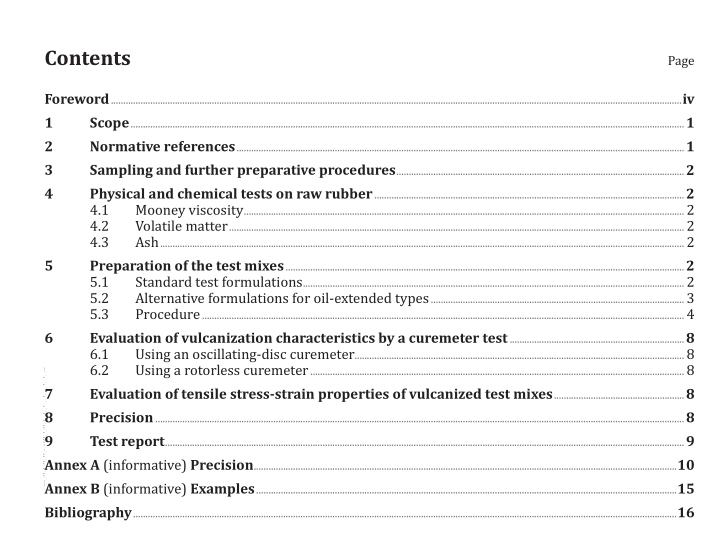ISO 2322 pdf download

ISO 2322 pdf download Styrene-butadiene rubber (SBR) — Emulsion- and solution-polymerized types — Evaluation procedures
IS0289-1,Rubber, unvulcanized- Determinationsusing ashearing-discviscometer-Part1: DeterminationofMooney viscosity
ISO 1795, Rubber; raw natural and raw synthetic — Sampling and further preparative procedures
ISO 2393, Rubber test mixes- Preparation, mixing and vulcanization – Equipment and procedures
ISO 3417, Rubber – Measurement ofvulcanization characteristics with the oscillating disc curemeter
ISO 6502 Rubber – Guide to the use ofcuremeters
ISO 23529,Rubber– General procedures for preparing and conditioning testpieces for physical test methods
3 Sampling and further preparative procedures
31Take a laboratory sample of approximately 1,5 kg by the method described in ISO 1795
3.2Prepare test samples in accordance with ISO 1795
4 Physicaland chemical tests on raw rubber
4.1 Mooney viscosity
Determine the Mooney viscosity in accordance with ISO 289-1 on a test sample prepared in accordancewith the preferred method ofISO 1795 (unmilled test sample). Record the result as ML(1 + 4) at 100 °.
If ML(1 + 4) at 100 °C exceeds 100 Mooney units, the small rotor can be used and the result reported asMS(1 + 4) at 100C.
Alternatively, the Mooney viscosity can be determined on a test sample prepared by the mill massingprocedure of ISO 1795. However, this method gives poorer reproducibility and the results might bedifferent.
4.2 Volatile matter
Determine the volatile-matter content by the hot-mill method or by the oven method as specified inIS0 248-1 andIS0 248-2.
4.3Ash
Determine the ash in accordance with method A or method B ofISO 247:2006.
5 Preparation of the test mixes
5.1 Standard test formulations
The standard test formulations are given in Table 2
The materials shall be national or international standard reference materials.
If no standard reference material is available, the materials to be used shall be agreed by the partiesconcerned.
5.2 Alternative formulations for oil-extended types ASTM D 3185 specifies the test formulations given in Table 3 for evaluation of general-purpose, oil- extended SBR, depending on the oil content of the rubber. These test formulations can be used as alternatives to the test formulations given in Table 2.
5.3 Procedure
5.3.1 Equipment and procedure The equipment and procedure for the preparation, mixing, and vulcanization shall be in accordance with ISO 2393. Three alternative mixing procedures are specified, but in accordance with ISO 2393, the laboratory internal mixer procedure is preferred.
— Method A: mill mixing.
— Method B: single-stage mixing using a laboratory internal mixer (the preferred procedure).
— Method C: two-stage mixing using a laboratory internal mixer for initial mixing and a mill for final mixing.
5.3.2 Method A — Mill-mixing procedure The standard laboratory mill batch mass, in grams, shall be based on four times the formulation mass (i.e. 4 × 156,75 g = 627 g or 4 × 141,75 g = 567 g). Maintain the surface temperature of the rolls at 50 °C ± 5 °C. Maintain a good rolling bank at the nip of the rolls during mixing. If this is not obtained with the nip settings specified hereunder, small adjustments to the mill openings might be necessary.









